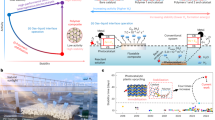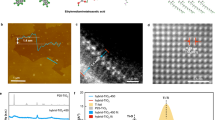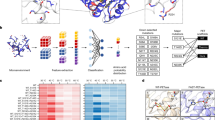Abstract
Biocatalytic artificial photosynthesis integrates photocatalysis and redox biocatalysis to synthesize value-added chemicals using solar energy. However, this nature-inspired approach suffers from sluggish rates of reaction because of challenging water oxidation kinetics. Here we report photoelectrochemical biosynthetic reactions that use non-recyclable real-world poly(ethylene terephthalate) (PET) microplastics as an electron feedstock. A Zr-doped haematite photoanode extracts electrons from hydrolysed PET solutions obtained from post-consumer PET waste, such as drinks bottles, and transfers the electrons to the bioelectrocatalytic site. Carbon-based cathodes receive the electrons to activate redox enzymes (for example, unspecific peroxygenase, L-glutamate dehydrogenase and ene-reductase from the old yellow enzyme family) that drive various organic synthetic reactions. These reactions include oxyfunctionalization of C–H bonds, amination of C=O bonds and asymmetric hydrogenation of C=C bonds. These photoelectrocatalytic–biocatalytic hybrid reactions achieve total turnover numbers of 362,000 (unspecific peroxygenase), 144,000 (L-glutamate dehydrogenase) and 1,300 (old yellow enzyme). This work presents a photoelectrocatalytic approach for integrating environmental remediation and biocatalytic photosynthesis towards sustainable solar-to-chemical synthesis.

This is a preview of subscription content, access via your institution
Access options
Subscribe to this journal
Receive 12 digital issues and online access to articles
$119.00 per year
only $9.92 per issue
Buy this article
- Purchase on SpringerLink
- Instant access to full article PDF
Prices may be subject to local taxes which are calculated during checkout






Similar content being viewed by others
Data availability
The data supporting the findings of the study are available in the paper and its Supplementary Information. Source data are provided with this paper.
References
Ryberg, M. W., Laurent, A. & Hauschild, M. Mapping of Global Plastics Value Chain and Plastics Losses to the Environment (United Nations Environment Programme, 2018).
Adyel, T. M. Accumulation of plastic waste during COVID-19. Science 369, 1314–1315 (2020).
Garcia, J. M. & Robertson, M. L. The future of plastics recycling. Science 358, 870–872 (2017).
MacArthur, E. Beyond plastic waste. Science 358, 843–843 (2017).
Ryan, P. G. in Marine Anthropogenic Litter (eds Bergmann, M. et al.) 1–25 (Springer, 2015).
Law, K. L. & Thompson, R. C. Microplastics in the seas. Science 345, 144–145 (2014).
The New Plastics Economy – Rethinking the Future of Plastics (World Economic Forum, Ellen MacArthur Foundation and McKinsey & Company, 2016).
Singh, A. K., Yasri, N., Karan, K. & Roberts, E. P. L. Electrocatalytic activity of functionalized carbon paper electrodes and their correlation to the Fermi level derived from Raman spectra. ACS Appl. Energy Mater. 2, 2324–2336 (2019).
Molina-Espeja, P., Ma, S., Mate, D. M., Ludwig, R. & Alcalde, M. Tandem-yeast expression system for engineering and producing unspecific peroxygenase. Enzyme Microb. Technol. 73–74, 29–33 (2015).
Pognon, G., Brousse, T., Demarconnay, L. & Bélanger, D. Performance and stability of electrochemical capacitor based on anthraquinone modified activated carbon. J. Power Sources 196, 4117–4122 (2011).
Zhang, W. et al. Selective aerobic oxidation reactions using a combination of photocatalytic water oxidation and enzymatic oxyfunctionalizations. Nat. Catal. 1, 55–62 (2018).
Yoon, J. et al. Piezobiocatalysis: ultrasound-driven enzymatic oxyfunctionalization of C–H bonds. ACS Catal. 10, 5236–5242 (2020).
Kim, J., Nguyen, T. V. T., Kim, Y. H., Hollmann, F. & Park, C. B. Lignin as a multifunctional photocatalyst for solar-powered biocatalytic oxyfunctionalization of C–H bonds. Nat. Synth. 1, 217–226 (2022).
Kim, J. & Park, C. B. Shedding light on biocatalysis: photoelectrochemical platforms for solar-driven biotransformation. Curr. Opin. Chem. Biol. 49, 122–129 (2019).
Ko, J. W. et al. Self-assembled peptide–carbon nitride hydrogel as a light-responsive scaffold material. Biomacromolecules 18, 3551–3556 (2017).
Murugesan, K. et al. Catalytic reductive aminations using molecular hydrogen for synthesis of different kinds of amines. Chem. Soc. Rev. 49, 6273–6328 (2020).
Lee, Y. W. et al. Unbiased biocatalytic solar-to-chemical conversion by FeOOH/BiVO4/perovskite tandem structure. Nat. Commun. 9, 4208 (2018).
Chaudhari, N., Landin, A. M. & Roper, S. D. A metabotropic glutamate receptor variant functions as a taste receptor. Nat. Neurosci. 3, 113–119 (2000).
Sun, C. et al. L-Glutamate treatment enhances disease resistance of tomato fruit by inducing the expression of glutamate receptors and the accumulation of amino acids. Food Chem. 293, 263–270 (2019).
Hou, Y. & Wu, G. L-Glutamate nutrition and metabolism in swine. Amino Acids 50, 1497–1510 (2018).
Wang, D. et al. Lignin-fueled photoelectrochemical platform for light-driven redox biotransformation. Green Chem. 22, 5151–5160 (2020).
Son, E. J., Lee, Y. W., Ko, J. W. & Park, C. B. Amorphous carbon nitride as a robust photocatalyst for biocatalytic solar-to-chemical conversion. ACS Sustain. Chem. Eng. 7, 2545–2552 (2019).
Kim, J. et al. Nicotinamide adenine dinucleotide as a photocatalyst. Sci. Adv. 5, eaax0501 (2019).
Mifsud, M. et al. Photobiocatalytic chemistry of oxidoreductases using water as the electron donor. Nat. Commun. 5, 3145 (2014).
Shen, S., Lindley, S. A., Chen, X. & Zhang, J. Z. Hematite heterostructures for photoelectrochemical water splitting: rational materials design and charge carrier dynamics. Energy Environ. Sci. 9, 2744–2775 (2016).
Kim, J. H. & Lee, J. S. Elaborately modified BiVO4 photoanodes for solar water splitting. Adv. Mater. 31, 1806938 (2019).
Liu, X., Wang, F. & Wang, Q. Nanostructure-based WO3 photoanodes for photoelectrochemical water splitting. Phys. Chem. Chem. Phys. 14, 7894–7911 (2012).
Heo, Y., Kim, K., Kim, J., Jang, J. & Park, C. B. Near-infrared-active copper bismuth oxide electrodes for targeted dissociation of Alzheimer’s β-amyloid aggregates. ACS Appl. Mater. Interfaces 12, 23667–23676 (2020).
Uekert, T., Kasap, H. & Reisner, E. Photoreforming of nonrecyclable plastic waste over a carbon nitride/nickel phosphide catalyst. J. Am. Chem. Soc. 141, 15201–15210 (2019).
Uekert, T., Kuehnel, M. F., Wakerley, D. W. & Reisner, E. Plastic waste as a feedstock for solar-driven H2 generation. Energy Environ. Sci. 11, 2853–2857 (2018).
Iandolo, B., Wickman, B., Zorić, I. & Hellman, A. The rise of hematite: origin and strategies to reduce the high onset potential for the oxygen evolution reaction. J. Mater. Chem. A 3, 16896–16912 (2015).
Xiao, M., Luo, B., Wang, Z., Wang, S. & Wang, L. Recent advances of metal-oxide photoanodes: engineering of charge separation and transportation toward efficient solar water splitting. Sol. RRL 4, 1900509 (2020).
Liao, P., Toroker, M. C. & Carter, E. A. Electron transport in pure and doped hematite. Nano Lett. 11, 1775–1781 (2011).
Nam, D. H. et al. Water oxidation-coupled, photoelectrochemical redox biocatalysis toward mimicking natural photosynthesis. Appl. Catal. B 198, 311–317 (2016).
Son, E. J. et al. Carbon nanotube–graphitic carbon nitride hybrid films for flavoenzyme-catalyzed photoelectrochemical cells. Adv. Funct. Mater. 28, 1705232 (2018).
Choi, D. S., Kim, J., Hollmann, F. & Park, C. B. Solar-assisted eBiorefinery: photoelectrochemical pairing of oxyfunctionalization and hydrogenation reactions. Angew. Chem. Int. Ed. 59, 15886–15890 (2020).
Choi, D. S. et al. Bias-free in situ H2O2 generation in a photovoltaic–photoelectrochemical tandem cell for biocatalytic oxyfunctionalization. ACS Catal. 9, 10562–10566 (2019).
Burek, B. O. et al. Photoenzymatic hydroxylation of ethylbenzene catalyzed by unspecific peroxygenase: origin of enzyme inactivation and the impact of light intensity and temperature. ChemCatChem 11, 3093–3100 (2019).
Perry, S. C. et al. Electrochemical synthesis of hydrogen peroxide from water and oxygen. Nat. Rev. Chem. 3, 442–458 (2019).
Kuk, S. K. et al. CO2-reductive, copper oxide-based photobiocathode for Z-scheme semi-artificial leaf structure. ChemSusChem 13, 2940–2944 (2020).
Kim, J. et al. Robust FeOOH/BiVO4/Cu(In,Ga)Se2 tandem structure for solar-powered biocatalytic CO2 reduction. J. Mater. Chem. A 8, 8496–8502 (2020).
Kim, J. et al. Unbiased photoelectrode interfaces for solar coupling of lignin oxidation with biocatalytic C═C bond hydrogenation. ACS Appl. Mater. Interfaces 14, 11465–11473 (2022).
Grätzel, M. Photoelectrochemical cells. Nature 414, 338–344 (2001).
Rudroff, F. et al. Opportunities and challenges for combining chemo- and biocatalysis. Nat. Catal. 1, 12–22 (2018).
Lee, S. H., Choi, D. S., Kuk, S. K. & Park, C. B. Photobiocatalysis: activating redox enzymes by direct or indirect transfer of photoinduced electrons. Angew. Chem. Int. Ed. 57, 7958–7985 (2018).
Le, T.-K. et al. Solar-powered whole-cell P450 catalytic platform for C-hydroxylation reactions. ChemSusChem 14, 3054–3058 (2021).
Wang, D., Kim, J. & Park, C. B. Lignin-induced CaCO3 vaterite structure for biocatalytic artificial photosynthesis. ACS Appl. Mater. Interfaces 13, 58522–58531 (2021).
Son, G., Kim, J. & Park, C. B. Interference of solvatochromic twist in amyloid nanostructure for light-driven biocatalysis. ACS Appl. Energy Mater. 3, 1215–1221 (2020).
Kim, J. et al. Biocatalytic C=C bond reduction through carbon nanodot-sensitized regeneration of NADH analogues. Angew. Chem. Int. Ed. 57, 13825–13828 (2018).
Schmermund, L. et al. Photo-biocatalysis: biotransformations in the presence of light. ACS Catal. 9, 4115–4144 (2019).
Hollmann, F., Arends, I. W. C. E. & Buehler, K. Biocatalytic redox reactions for organic synthesis: nonconventional regeneration methods. ChemCatChem 2, 762–782 (2010).
Chen, H. et al. Fundamentals, applications, and future directions of bioelectrocatalysis. Chem. Rev. 120, 12903–12993 (2020).
Ruff, A., Conzuelo, F. & Schuhmann, W. Bioelectrocatalysis as the basis for the design of enzyme-based biofuel cells and semi-artificial biophotoelectrodes. Nat. Catal. 3, 214–224 (2020).
Ren, Y. et al. Strategies to suppress hydrogen evolution for highly selective electrocatalytic nitrogen reduction: challenges and perspectives. Energy Environ. Sci. 14, 1176–1193 (2021).
Lin, C.-Y., Huang, S.-C., Lin, Y.-G., Hsu, L.-C. & Yi, C.-T. Electrosynthesized Ni–P nanospheres with high activity and selectivity towards photoelectrochemical plastics reforming. Appl. Catal. B 296, 120351 (2021).
Perini, N. et al. Photoelectrochemical oxidation of glycerol on hematite: thermal effects, in situ FTIR and long-term HPLC product analysis. J. Solid State Electrochem. 25, 1101–1110 (2021).
Mesa, C. A. et al. Kinetics of photoelectrochemical oxidation of methanol on hematite photoanodes. J. Am. Chem. Soc. 139, 11537–11543 (2017).
Acknowledgements
This work was supported by the National Research Foundation (NRF) via the Creative Research Initiative Center (grant no. NRF-2015R1A3A2066191 (J.K., J.J. and C.B.P.)) and the Global PhD Fellowship Program (grant no. NRF-2019H1A2A1075810 (J.K.)), Republic of Korea.
Author information
Authors and Affiliations
Contributions
J.K. conceived and designed the research, performed (photo)electrocatalytic/bioelectrocatalytic/photobiocatalytic experiments, analysed the data and wrote the manuscript. C.B.P. supervised the research. J.K., J.J. and C.B.P. discussed the photoelectrocatalysis. T.H. and F.H. provided J.K. and C.B.P. with the OYE and UPO enzymes. J.K., T.H. and F.H. commented on the biocatalysis. All authors contributed to revising the manuscript.
Corresponding author
Ethics declarations
Competing interests
The authors declare no competing interests.
Peer review
Peer review information
Nature Synthesis thanks Hao Song and the other, anonymous, reviewer(s) for their contribution to the peer review of this work. Primary handling editor: Peter Seavill, in collaboration with the Nature Synthesis team.
Additional information
Publisher’s note Springer Nature remains neutral with regard to jurisdictional claims in published maps and institutional affiliations.
Supplementary information
Supplementary Information
Supplementary Methods, Tables 1–10 and Figs. 1–25.
Source data
Source Data Fig. 2
Raw data on H2O2 production (Fig. 2b), hydroxylation rate (Fig. 2c), NADH formation (Fig. 2f), amination rate (Fig. 2g) and hydrogenation rate (Fig. 2h) and their statistical information (for example, mean, standard deviation and P values).
Source Data Fig. 3
Raw data on the production of formate and acetate by PEC reformation of microplastics and their corresponding statistical data (for example, mean, standard deviation and P values).
Source Data Fig. 4
Raw data on rates of photobiocatalytic reactions fuelled by microplastics and their statistical information (for example, mean, standard deviation and P values).
Rights and permissions
Springer Nature or its licensor holds exclusive rights to this article under a publishing agreement with the author(s) or other rightsholder(s); author self-archiving of the accepted manuscript version of this article is solely governed by the terms of such publishing agreement and applicable law.
About this article
Cite this article
Kim, J., Jang, J., Hilberath, T. et al. Photoelectrocatalytic biosynthesis fuelled by microplastics. Nat. Synth 1, 776–786 (2022). https://doi.org/10.1038/s44160-022-00153-x
Received:
Accepted:
Published:
Issue date:
DOI: https://doi.org/10.1038/s44160-022-00153-x
This article is cited by
-
Solar-driven electrolysis coupled with valuable chemical synthesis
Nature Reviews Clean Technology (2025)
-
The first year of Nature Synthesis
Nature Synthesis (2023)
-
Scalable electrosynthesis of commodity chemicals from biomass by suppressing non-Faradaic transformations
Nature Communications (2023)
-
Making molecules with microplastics
Nature Synthesis (2022)



